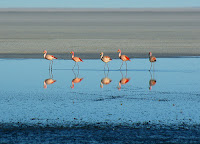Salar de Uyuni in South American Bolivia is referred to by many as the World’s Largest Mirror. Given that it spreads over an area of 4,085 square miles (10,582 square kilometres), it truly is a vast reflective surface but the most amazing part is that this large mirror is all natural.
Salar de Uyuni. Some 40,000 years ago, the area was part of Lake Minchin, a giant prehistoric lake. When the lake dried, it left behind two modern lakes, Poopó Lake and Uru Uru Lake, and two major salt deserts, Salar de Coipasa and the larger Uyuni. Uyuni is roughly 25 times the size of the Bonneville Salt Flats in the United States.
Salar de Uyuni was once a salt lake similar to the Dead Sea. There still is a salt lake at Salar de Uyuni, however it’s at the bottom, underneath the tens of meters of salt flats. It’s that brine which is covered by salt flats that’s an exceptionally rich source of lithium, however at present time there is no lithium mined out of Salar de Uyuni.
Compared to Bonneville Salt flats in Utah, USA, Salar de Uyuni has 25 time as much salt – about 10 billion tonnes. Less than 25,000 tonnes of salt are extracted from the salt flats annually.












No comments:
Post a Comment